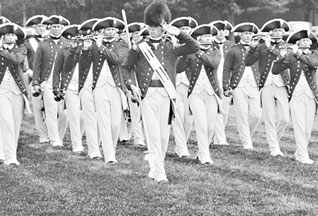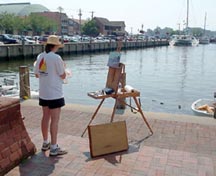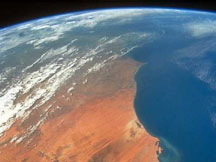The Armed Forces’ military bands — resounding with some of the nation’s finest musicians — thrive throughout Bay Country, performing music ranging from rousing patriotic standards to the symphonies of classical masters to cool jazz to Top 40 pop hits. Come summer, many of their concerts go outdoors. What’s more, they’re always free.
The U.S. Naval Academy has a fine band, and within that band are many combos: the Concert Band, the Electric Brigade, Next Wave, the woodwind quintet, two brass quintets, the clarinet quartet, the trombone quartet, the tuba-euphonium quartet, two ceremonial bands and the marching band.
You can hear many of them this summer throughout Chesapeake Country, including on the idyllic Academy grounds. Security is still on alert; park and walk in Gate 1; over 16, bring a photo id (410/293-0263 • www.usna.edu/usnaband).
The season starts July 4, at 8pm at Farragut field where the band gets you in a patriotic mood for the fireworks to follow. Come Aug. 8, it’s the Electric Brigade’s turn.
Meanwhile, the academy makes summer music at other spots as well. On summer Tuesdays they play their Summer Serenade Concert Series at Annapolis’ City Dock. July 9 begins the series. It ends August 13 (rain date Aug. 15) with a Musical Extravaganza of the band and all its combos — plus the “1812 Overture” with real cannon fire.
Further afield, you’ll hear the Electric Brigade July 7 at Downs Park, Pasadena at 6pm. To the west, listen in Sundays at Bowie’s Allen Pond Park. The Concert Band plays July 7 and the Electric Brigade July 21: 301/809-3076.
Naval Academy also hosts other superb Washington-area military bands for its Guest Series (7:30pm Th @ Rip Miller Field, U.S. Naval Academy). This year it’s the Army Blues July 18, the Navy Cruisers rock band July 15 and the Navy’s Country Current Aug. 1.
 Washington military bands also travel throughout Chesapeake Country in summer, making sound waves throughout the region as ensembles drift from the Capitol steps to Bethany Beach, Delaware, with frequent stops locally in Anne Arundel and Calvert counties.
Washington military bands also travel throughout Chesapeake Country in summer, making sound waves throughout the region as ensembles drift from the Capitol steps to Bethany Beach, Delaware, with frequent stops locally in Anne Arundel and Calvert counties.
When in Washington you can find grand military music most days of the week at two spots on the National Mall. All concerts are free, but bring lawn chairs or blankets — plus a picnic.
- At the U.S. Capitol Lawn: Mondays June 24-Aug. 26, except July 1. Navy Band on South Lawn; Tuesdays Air Force Band 8pm on West Lawn; Wednesdays except July 3, Marine Band, 8pm,
- At Sylvan Theater, on the south side of the Washington Monument: Sundays, Marine Band 8pm on West Lawn; Wednesdays, July 24 & 31, Twilight Tattoo w/the Army Band at 7pm; Fridays, Air Force Band at 8pm.
The U.S. Navy band also makes a summer ritual of performing on Tuesday evenings at the Navy Memorial. Hear them or an ensemble June 25 thru Aug. 27 (8pm @ 701 Pennsylvania Ave., NW: 202/433-2525 • www.navyband.navy.mil).
All military band concerts are free and need no tickets. Weather dependent. For updates and new dates, call the bands: Navy 202/433-2525; Marine 202/433-4011; Army 202/685-2851 • www.mdw.army.mil; Air Force 202/767-5658.
52. Keep a Summer Journal
Old-fashioned cooks had only one season to put away all the food for a year. Their canning kept them in summer all winter long. There’s a lesson for all of us there.
Many of the pleasures of Chesapeake Country are as seasonal as peaches. How often do you sit out on the deck or the dock on a winter’s evening and watch the sky fill with stars? What day last year did you eat your first home-grown tomato? And how does your Mortgage Lifter tomato compare to your Early Girl? What was the great recipe you cooked up when the zucchini grew rampant? How long did this year’s fireworks light up the sky? Who did you play with on the beach? When did the horseshoe crabs come? How many visitors came to see you because you live in such a fine part of the world?
Those are memories to warm you in winter — if you lay them away now. Don’t trust your brain to store them. You need a stronger jar. Write them down, whether on computer, in your desk calendar, or in one of those lovely blank books you’re always wondering what to do with.
Start and end wherever you choose. Don’t get scared away by thinking you’ve got to record every event. Write what you like best. Train yourself to find the right word for the tastes and smells and colors you want to remember. The secret is simply doing it. Keep your book nearby, or make a special time. Your fingers will do the rest. Soon, you’ll be surprising yourself at the beauty of your words and the sharpness of your insights.
Inside you is a great writer longing to be allowed words. Give words to your writer this summer.
53. Get Romantic on a Steamy Summer Night
Go ahead and splurge. After a day on the Bay or alongside it, take a little break to prepare for a big night out. Shower up, moisturize your skin and put on your summer finest; white is ideal.
Head to that restaurant or crab house where you’ve always wanted to go. Hold out for a table by the window, then order a tall, cool rum drink to get things going. Chat a bit, you’re in no hurry. Stop to see the sun drop off the hazy horizon. Recall last night’s dream. Then order something you don’t often get and share it with your partner.
If you’re up to it, call for an after-dinner drink while you talk some more. Leave behind a generous tip and hold hands going out the door. Now take a stroll or head on home. And though it may be late, don’t fall asleep.
54. Tour the Historic Sites You Pass Every Day
You’ve been living in Chesapeake Country for 15 years or maybe your entire life, but you’ve never seen the pond in the shape of a fish hidden behind the brick walls of the William Paca House in Annapolis.
Maybe you’ve spent years walking by Shiplap House, also in Annapolis, thinking it was named after a former owner. You’d be wrong. Shiplap refers to the exterior siding on the rear of the building, a technique that was used primarily in ship building.
How about London Town in Edgewater? On your way to work, you probably drive by without a thought for the ongoing archeological dig taking place there. And on Broomes Island Road on the grounds of Christ Church in Port Republic stands One Room School House No. 7, where, until the 1930s, seven grades of students were educated.
Take a tour of the historic sites you see every day and learn more interesting tidbits that you can use to impress visiting family and friends. If you’re embarrassed that you’ve lived here so long and haven’t learned the local history, tell everyone you’re from Minnesota or Maine. No one will mind. It’ll give you a chance to see and appreciate your home the way tourists do.
Here’s some places to learn our local history:
 55. NJFK: Paint Like Monet
55. NJFK: Paint Like Monet
Monet once said, “I love water so much. I hope that when I die they bury me in a buoy and I can bounce up and down for all eternity.” Monet was fascinated by the play of light on the water. He used very light, fast brush strokes creating moods or impressions, rather than realistic portraits; hence his style came to be known as Impressionism. His critics said he didn’t use enough paint.
What are your impressions when you go down to the Bay? Use all of your senses. Do you see sailboats playing on the water? Can you feel the warmth of the sun on the back of your neck? Do you hear the gulls and osprey? How does it make you feel? Can you paint the feeling?
Monet painted a series of paintings that studied the character of the light at different times during the day. Notice the light on the water at daybreak, at midday and at dusk. Study the shadows and the color of the light. Can you paint the same scene at different times during the day? Can your friends tell what time of day it is by looking at your painting?
56. Find Out Where in the World You Are
Compasses tell you where you’re going. GPS tells you where in the whole wide world you are. The Global Positioning System is not a military secret anymore. Nowadays, for about $100, you can get a neat little cell-phone-size receiver that will pinpoint your location within 30 feet.
 This everyday miracle works by connecting you with a team of the many human-made satellites now orbiting Earth. Your receiver measures and compares distances to compute your position.
This everyday miracle works by connecting you with a team of the many human-made satellites now orbiting Earth. Your receiver measures and compares distances to compute your position.
Your answer will come in latitude and longitude, degrees, minutes and seconds. Match those numbers with the latitude and longitude on your nautical chart, and voila!
GPS works on land as well as on sea. On your maps, latitude and longitude are the easy-to-miss pairs of numbers often paired with the alpha-numeric grid. That scale won’t get you as close as 30 feet, but on land you’ll have landmarks to help you.
GPS can also remember where you’ve been. With the touch of a button, the GPS marks the coordinates. You’ll never lose ‘site’ of your favorite fishing hole — or anyplace else on sea or land you want to return to. Once you’ve mastered how to use it, GPS will tell you how to come back.
In short, the GPS can tell you where you are, where you’re going and where you’ve been. Just don’t expect it to tell you who you are.
57. Enlarge Your World
Now that you know where you are, go on to the next spot.
Afoot or afloat, airborne or undersea, on wheels, on the Moon or with your head in the stars, there’s a map that can help you get there and back again.
On water, maps become charts. The big two, compilations, are the ADC Chesapeake Bay chart book or the Maryland Cruising Guide, the latter produced right here in Chesapeake Country by Mickey Courtney. Both are developed from NOAA charts, which are sold in sheets rather than books. Find a range of charts at most boating stores.
On charts, land is little more than a coast line, but water is mapped in full detail, including depth, channel markers, hazard to navigation and works in progress. With the compass rose and latitude and longitude clearly in place, you can navigate your own compass course from point to point — assuming you’ve learned that skill. Just in case, there are also ready made courses to follow, with commonly used magnetic bearings showing you the safe way to get from place to place.
If you want to come home again, learn to use your chart (Coast Guard Auxiliary and Power Squadron Safe Boating courses, regularly listed in 8 Days a Week, are good places), and don’t go on the water without one.
For local terrestrial navigation, when you get beyond state highway maps, try using the Delorme Maryland Delaware Atlas & Gazetteer.
It used to be you’d need a map store to sample a full variety of maps, but nowadays the big bookstores have solid map sections plus lots of books mapping getaways for all sorts of travels and tastes. Of course, for finding your way at the local level, you can’t beat ADC county maps, which you can find at most convenience stores.
Good companion tools are a compass and GPS.
58. Throw a Frisbee
Summer and Frisbees go together like baseball and hot dogs, and there are several ways to play with a flying disk besides the usual game of catch. You can teach your dog to grab Frisbees from midair, of course, but more immediate satisfaction comes from a round of Frisbee golf.
Pick a target — like a fire hydrant or a tree. Start from far away and see how many throws it takes you to hit your target. If you’re playing against an opponent, fewest throws wins.
Ready for something a little more demanding? Take a tip from Generation X and try Frisbee football (otherwise known as Ultimate Frisbee, or just Ultimate). Be ready to break a sweat: Frisbee football requires almost as much running around as World Cup soccer.
You’ll need a large, level yard or field with goal areas at either end and two teams; both teams need at least two players. Line up in the goal area you’ll defend and throw the Frisbee toward the opposing team — or get ready to catch it. Whoever catches the Frisbee has 10 seconds to throw it to a teammate. If you or your teammate catches the Frisbee in the opposing team’s goal area, you score one point. Then you go back to your goal area and throw the Frisbee to the opposing team, and so on. It’s that simple.
There are a few more rules, though:
- Most important, you can’t move while holding the Frisbee; you must freeze until you throw it.
- If you take longer than 10 seconds to throw the Frisbee, if you throw it out of bounds or if it falls to the ground — either because someone missed catching it or simply dropped it — hand the Frisbee to someone from the opposing team so they can throw it.
- It’s the opposing team’s responsibility to count to 10 when you have the Frisbee. The opposing player nearest you should count one alligator (or banana or whatever), two alligator and so on.
- Last, but not least, no physical contact is allowed between players. Violate this rule, and be forever scorned and derided.
 59 . Savor Summer Specialties: Make a Watermelon Boat
59 . Savor Summer Specialties: Make a Watermelon Boat
Watermelon boats are hollowed out watermelons used to hold a variety of fresh fruit.
Start with a medium-size watermelon; a seedless variety will make the job easier. Cut off about the top third of the melon. Think before you cut, maybe even sketch out the design on the rind with a pencil the way you would on a pumpkin at Halloween. Remember, you will put all the melon balls back into the hollowed-out rind.
You can cut it into a basket shape with a jagged or wavy edge or in the shape of a bassinet.
After cutting off the top, scoop out all the flesh with a melon baller. You can find these in any grocery store. Place the flesh in a large bowl. Don’t worry, the melon balls don’t have to be perfectly round.
Do the same for two cantaloupes and two honeydew melons, but for these you’ll throw away the rind so don’t worry about how you slice them open. Just cut them in half.
Put all the melon balls into the watermelon boat, alternating between the watermelon, cantaloupe and honeydew to get a pleasing mix of colors. Garnish with strawberries and blueberries, chill for a few hours and set your boat out with a barbecue.
60. NJFK: Have a Seed-Spitting Contest
You’ve used the watermelon’s shell and its flesh. What to do with the seeds?
Jason Schayot of Bastrop, Texas, set a world record with his seed-spitting aptitude, splurting one watermelon seed 75 feet, two inches at the 1996 DeLeon Peach & Melon Festival. You have all summer to shoot for 76 and bring the title to Bay Country.
First off, get a few friends together and have a tape measure handy. If you want to be professional about it, find a flat stretch of pavement (not the street, mind you) and keep a couple spotters off to the sides of your spitting lane to judge where it first lands.
To hurtle a seed even half the record distance, you’ll need to be picky. The best seed, as chosen by Schayot, is a small, dense, dark seed from near the center of the melon. A flimsy white seed will probably end up landing on your shirt while a big fat seed has too much wind resistance to go the distance. You’ll want to use your seed fresh while it’s good and slippery.
Try to position yourself with any breeze at your back. Put the seed on your tongue so that the fat end points forward. Fill your cheeks up with air, pucker up tight and … patooey! You’ll want to angle your trajectory up a little to get good distance, and try not to target passersby.
Finally, to figure out your spitting range, measure the distance from the toe of your front foot to the spot where the seed first landed. Practice often and you might eventually perfect the spitting form you’ll need to become a world-champion seed-spitter.